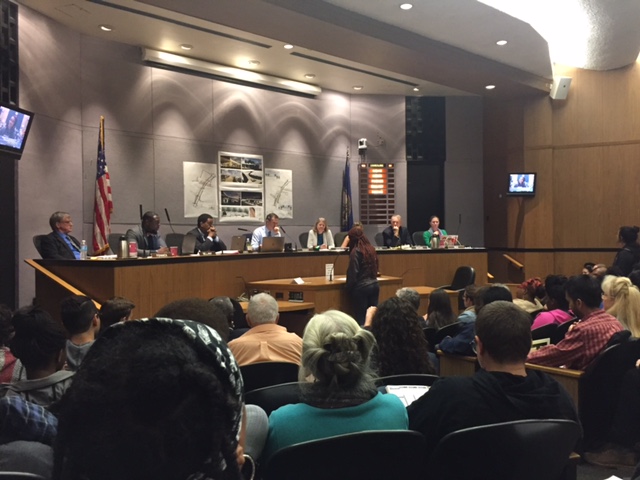Clashes at City Council
Jenna Goldman '18
(she/her/hers)
Editor-in-Chief
The Charlottesville City Council meeting on Monday, October 16 attracted a crowd of over 100 residents to participate in public comment on the city council’s response to the violent “Unite the Right” rallies in Charlottesville on August 11 and 12.
Charlottesville citizens listen to public comments. Photo courtesy of Jenna Goldman.
Though there were no metal detectors or bag searches that occurred before entering the City Hall building on East Main Street on the Downtown Mall, there were two police officers at the door of the building, two more at the front of the city council meeting room, and one patrolling the hall.
Roughly twenty minutes before the start of the meeting, the room was filled and a palpable anger hung in the air. Sixty-five days after the protests, emotions were still raw.
Vice Mayor Wes Bellamy opened the meeting outlining the agenda, from the start of the public hearing about the proposed responses to the KKK rallies on July 8, and the “Unite the Right” rallies on August 11-12. In reference to the extended public comment period, Bellamy said, “Those who are passionate in the quest for change and equity, and those who are emotionally scarred must be heard.” Each member was allotted three minutes to speak.
After the public comments the commission was slated to discuss an independent citizen review board about housing rent vouchers. Bellamy also remarked that he hoped the meeting would remain civil so the council could address the remaining agenda items.
Councilor Kristin Szakos presided over the public comment portion of the meeting and made a point that disruption and use of foul language would not be tolerated, motioning to the police officers standing in the back of the room. Protestors had shut down the previous week’s meeting.
The meeting lasted two hours, and two dozen people stood up to speak before the council on a variety of issues.
Many members discussed the changing of the hastily named “Emancipation Park,” formerly known as “Lee Park,” where the now-shrouded statue of Robert E. Lee still stands at the center of the downtown district, blocks from city hall. One woman suggested the name be changed to a more neutral “Charlottesville City Park” or “Court Square Park” in reference to its proximity to the courthouse.
Another heated topic was the school district’s slow response to FBI intelligence about threats to a Charlottesville elementary school. “I’m afraid for my life every day I walk out the door, my children are threatened at school. I can’t even sleep at night,” said one resident, a sentiment that was echoed throughout the evening.
Meeting attendants passed out flyers that detailed a list of demands, including the dropping of charges against DeAndre Harris, a black man who was beaten by several white attackers in a parking garage on August 12. The City Manager Maurice Jones responded to comments about Harris by stating that the issue is now being handled by the judiciary and will be up to the Commonwealth’s Attorney to drop or move forward with charges.
Charlottesville citizens listen to public comments. Photo courtesy of Jenna Goldman.
The consensus of the meeting was “Something needs to be done. I’m hurt, I’m frustrated, and I’m tired.” Many simply wanted an apology to be made by the City Council and an acknowledgement of its failure.
Professor Molly Brady’s State and Local Government class was in attendance to observe the process of Charlottesville local government.
Sarah Legault ’18, who attended for the class made a few observations. “The visceral tension at the meeting reminded me of the tension in St. Louis in 2014 when protests broke out in Ferguson and St. Louis City.” Legault, a graduate of Washington University in St. Louis, worked at that time for a small law firm that did work for local governments and followed the protests closely.
“I think I knew St. Louis better and felt more integrated into the community,” said Legault, contrasting her experience in Charlottesville: “I’ve been disconnected from the extent of the tension in some parts of the city.”
“Watching the public hearing, I felt like the city council had a hopeless job when it came to responding to the citizens’ concerns.” She said from a budding lawyer’s perspective, “There is no way to make the First Amendment seem relevant to people who feel truly threatened.”
One by one, audience members spoke about their frustration with the police department and the unequal protection of “free speech.” The frustration was best encapsulated by a comment made by one black Charlottesville resident, who motioned to his body as he said, “If I was carrying a tiki-torch, I would not have been free to go like the KKK were.”
Alli Herzog ’18 agreed. “I definitely sympathize with the frustration expressed at the meeting, that police appeared to treat the Nazis with a lot of respect and carefulness.” As for the intersection of their legal studies and the public comments before city council, “There is a communication barrier because of the legal aspects, which seems to increase frustration.”
Legault expanded, “Discussions about the First Amendment and the law may just not be able to encompass the lived experiences people at the meeting voiced.”
Mayor Signer weighed in, “These [events] are not free speech, this is now conduct that is meant to hurt, intimidate, frighten, threaten and make people feel unwelcome here.”
The meeting ended with Bellamy introducing a request from the Police Citizen’s Advisory Panel to amend its bylaws to have more authority in the panel’s responses. The council voted unanimously to authorize the panel to either amend its bylaws or to create a citizen review board in place of the panel to advise the Charlottesville Police Department.
---
jmg3db@virginia.edu


